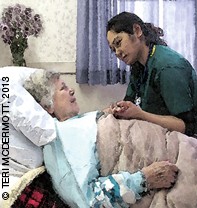Peer Reviewed
Feature Article Palliative care
Pain relief and the end of life
Abstract
Good pain control is possible in most patients in the months, weeks and days preceding death. This leads not only to better patient care but also to a better bereavement experience for families.
Key Points
- Patients with a terminal illness worry about their level of discomfort, especially pain, at the end of life. However, effective pain control is possible in most palliative care patients.
- Misconceptions about medications for pain relief can be barriers to treatment; addiction is rare and most adverse side effects can be managed.
- Good pain management is important in the weeks and months leading up to the terminal phase. There is good evidence that effective pain relief at the end of life does not shorten life.
- A comprehensive assessment includes a detailed history and examination, with particular attention to musculoskeletal and neurological findings, and judicious symptom-directed investigations where appropriate.
- Patients and their families need education regarding what to expect when commencing strong analgesics.


